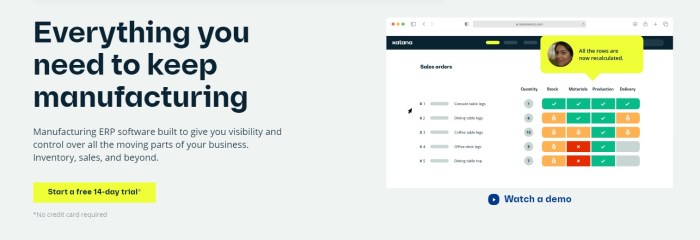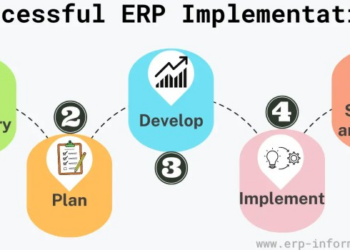Embark on a journey through the world of Katana Manufacturing ERP, where efficiency meets innovation to revolutionize the manufacturing landscape. From streamlining operations to enhancing decision-making, this powerful system offers a comprehensive solution for businesses seeking to excel in the industry.
Overview of Katana Manufacturing ERP
ERP, which stands for Enterprise Resource Planning, is a software system that helps businesses manage and integrate various aspects of their operations, including planning, inventory, production, sales, and finance. In the manufacturing industry, ERP systems play a crucial role in streamlining processes, improving efficiency, and enhancing overall productivity.
Importance of ERP Systems in Manufacturing
ERP systems are essential for manufacturing companies as they provide a centralized platform for managing all aspects of the production process. By integrating different departments and functions within the organization, ERP systems enable real-time data sharing and collaboration, leading to better decision-making and improved operational performance.
- Efficient Production Planning: ERP systems help manufacturers optimize production schedules, allocate resources effectively, and minimize lead times.
- Inventory Management: With features like real-time tracking and automated replenishment, ERP systems help manufacturers reduce excess inventory levels and avoid stockouts.
- Quality Control: ERP systems enable manufacturers to monitor and analyze quality metrics, identify defects early on, and implement corrective actions to ensure product quality.
- Supply Chain Visibility: By providing visibility into the entire supply chain, ERP systems help manufacturers track materials, manage suppliers, and mitigate risks associated with disruptions.
- Financial Management: ERP systems streamline financial processes, such as accounting, budgeting, and reporting, ensuring accurate financial data and compliance with regulations.
Having a robust ERP system like Katana Manufacturing ERP can significantly improve operational efficiency, reduce costs, and enhance customer satisfaction in the manufacturing industry.
Benefits of Implementing Katana Manufacturing ERP
Implementing Katana Manufacturing ERP offers a wide range of benefits for companies in the manufacturing sector. From improving efficiency in the manufacturing process to enhancing decision-making through data analytics, Katana ERP has a significant impact on inventory management and supply chain optimization.
Improved Efficiency in Manufacturing Process
- Streamlined production planning and scheduling to minimize downtime and optimize resource utilization.
- Automated workflows and real-time tracking of production activities to identify bottlenecks and address them promptly.
- Integration of all manufacturing processes into a centralized system for better coordination and communication among departments.
Impact on Inventory Management and Supply Chain Optimization
- Real-time visibility of inventory levels and demand forecasts to prevent stockouts or overstock situations.
- Optimized procurement processes based on accurate inventory data and supplier performance metrics.
- Efficient order fulfillment and delivery tracking to enhance customer satisfaction and retention.
Enhanced Decision-Making through Data Analytics and Reporting
- Access to comprehensive reports and dashboards for analyzing key performance indicators and making informed strategic decisions.
- Utilization of predictive analytics to anticipate market trends and customer demands for better resource allocation.
- Integration of business intelligence tools for generating actionable insights and improving operational efficiency.
Implementation Process of Katana Manufacturing ERP
Implementing Katana Manufacturing ERP in a manufacturing setting involves a structured approach to ensure a smooth transition and successful integration. Let's explore the steps involved, challenges organizations may face, and tips for a successful implementation process.
Steps Involved in Deploying Katana ERP System
- 1. Planning Phase: Define project scope, objectives, and timelines.
- 2. System Selection: Choose the right version of Katana ERP that aligns with your manufacturing needs.
- 3. Data Migration: Transfer existing data into the new ERP system accurately.
- 4. Training and Testing: Provide training to employees and conduct thorough testing of the system.
- 5. Go-Live: Implement the ERP system in stages to minimize disruptions to operations.
- 6. Evaluation and Optimization: Continuously monitor and optimize the system for improved efficiency.
Challenges During Implementation and How to Overcome Them
- 1. Resistance to Change: Address employee concerns through effective communication and training programs.
- 2. Integration Issues: Ensure seamless integration with existing systems through proper planning and testing.
- 3. Data Accuracy: Implement data validation processes to maintain data integrity during migration.
- 4. Budget Constraints: Prioritize key functionalities and phases to stay within budget constraints.
Tips for Successful Integration of Katana ERP
- 1. Involve Key Stakeholders: Engage key stakeholders throughout the implementation process for their inputs and support.
- 2. Customization: Tailor the ERP system to meet specific manufacturing requirements for optimal performance.
- 3. Continuous Training: Provide ongoing training to employees to maximize system utilization and productivity.
- 4. Regular Evaluation: Monitor system performance regularly and make necessary adjustments for continuous improvement.
Customization and Configuration of Katana Manufacturing ERP
Options for Customizing Katana ERP
Customizing a Katana ERP system involves tailoring the software to meet specific manufacturing needs. Businesses can choose from a range of options to customize their ERP system:
- Custom fields: Businesses can add custom fields to capture unique data points relevant to their production process.
- Workflow customization: Users can define and configure workflows to match their specific manufacturing processes.
- Integration with third-party apps: Katana ERP allows integration with other software tools to streamline operations.
Configuration Settings for Optimization
Configuring Katana ERP involves adjusting settings to optimize performance and enhance user experience. Some key configuration settings include:
- Inventory management settings: Businesses can set reorder points, safety stock levels, and other inventory parameters.
- Production scheduling settings: Users can configure lead times, production capacities, and resource allocation for efficient scheduling.
- User permissions and access control: Administrators can define roles and permissions to ensure data security and restrict access to sensitive information.
Tailoring Katana ERP to Unique Production Requirements
Businesses can tailor Katana ERP to align with their unique production requirements by:
- Creating custom reports: Users can generate customized reports to track specific KPIs and performance metrics.
- Implementing custom dashboards: Businesses can design dashboards to display relevant data and insights for better decision-making.
- Adapting workflows: Companies can adjust workflows to accommodate specific production steps or requirements.
Ultimate Conclusion

In conclusion, Katana Manufacturing ERP stands as a beacon of efficiency and optimization in the manufacturing realm. With its customizable features and seamless integration process, businesses can unlock their full potential and pave the way for future success.
Clarifying Questions
How does Katana ERP impact inventory management?
Katana ERP enhances inventory management by providing real-time visibility into stock levels, tracking, and demand forecasting.
What are some key features of a Katana Manufacturing ERP system?
Key features include production planning, order tracking, inventory management, and data analytics for informed decision-making.
How can businesses customize Katana ERP to meet specific needs?
Businesses can customize Katana ERP through tailored configuration settings, aligning the system with unique production requirements.











